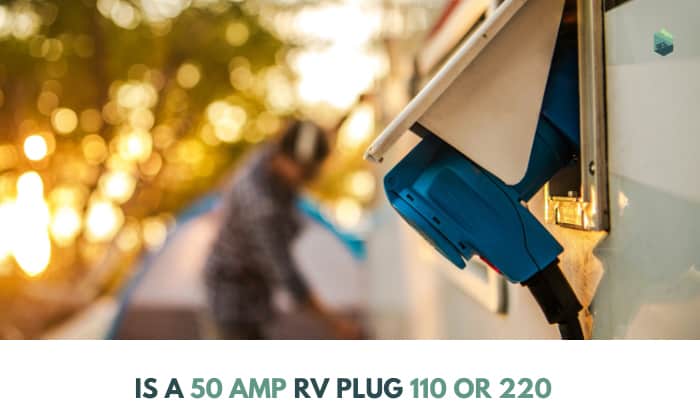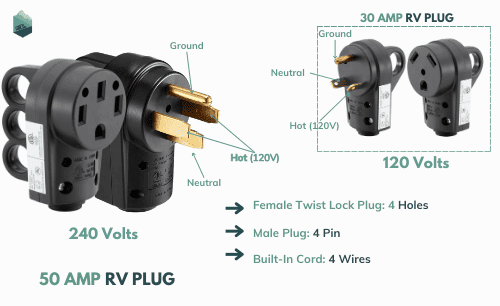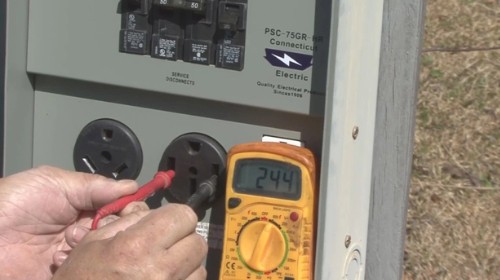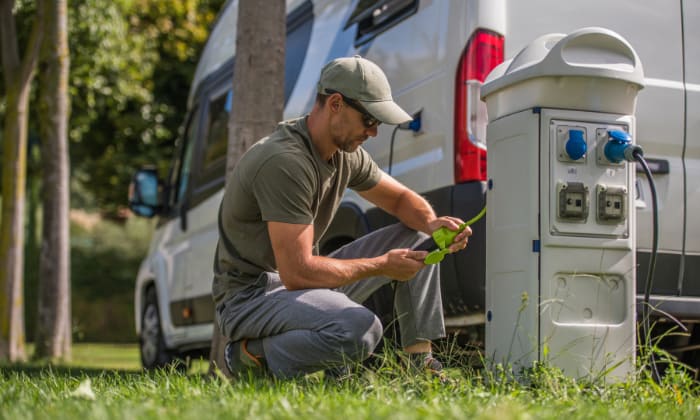It’s unsurprising to hear first-time RV owners ask, is a 50 amp RV plug 110 or 220? And while seasoned RVers might find this pointless, it remains a valid concern.
A 50 amp service is always 220 (or 240) volts because it has a unique design divergent from the usual 30-amp system we are more familiar with.
So, join us in exploring the “mysterious” world of the 50-amp system in recreational vehicles.
Page Contents
How Do You Check the Voltage on a 50 Amp RV Plug?
A related question to the issue is, how many volts is a 50 amp RV plug? Our most straightforward answer is 220 volts.
However, we also recognize some RVers might want a more concrete proof instead of relying on some website’s pronouncements.
So, we offer two ways to check the voltage on a 50 amp plug for motorhomes.
1. Examine the Plug and Outlet’s Design
This method is as straightforward as looking at a 50-amp plug adapter and its associated outlet. After all, the plug’s pins or prongs insert through holes in the electrical outlet. Hence, they should match.
Count how many prongs you see in the plug. If you see three, that’s a 30-amp system. If four pins are present, you have a 50-amp plug.
So, what’s the number of plug prongs have to do with the voltage?
Good question!
RV electrical systems aren’t any different from residential and commercial versions. Electricity passes through wires and terminates in a “hot” prong. Each “pin” accommodates 110 or 120 volts.
Plugs also have ground and neutral wires, but we will not talk about them here. What’s important is both 30- and 50-amp plugs have ground and neutral prongs.
So, subtracting these two wires (neutral and ground) from the plug’s three or four prongs gives us one (30-amp plugs) or two “hot” wires (50-amp plugs).
And since each “hot wire” carries 110 or 120 volts, having two means 220 or 240 volts.
2. Use a Multimeter
Although looking at the plug and receptacle’s design helps determine if you have a 30- or 50- amp system, you’d still want a more “accurate” test.
Here’s how to validate a 220V 50 amp system with a multimeter.
- Get a multimeter, turn it on, and set the dial to 200 volts. The device should display zero.
- Insert the red probe into the 12 o’clock hole on the RV plug and the black electrode into the 6 o’clock opening. The multimeter should read “zero” to indicate a good functioning ground wire.
- Remove the black probe and reposition it to the 3 o’clock slot. Read the multimeter value (it should be 110 or 120 volts).
- Repeat with the 9 o’clock opening (repositioning the black lead from the 3 o’clock hole).
- Combine the 3 and 9 o’clock readings, and you should get 240 volts (or 220 volts).
- If you want to be sure, reset the multimeter to 600 volts and insert one probe each in the 3 and 9 o’clock positions. You should read 220 or 240 volts.
Why Are There Various Options for RV Electrical Services?
Some RV appliances are more power-hungry than others, drawing more electricity.
For example, souped-up RVs with multiple ACs, entertainment systems, and full-suite kitchen and laundry facilities require more watts than a traditional 30-amp system can produce.
A 30-amp system can only provide a maximum of 3,600 watts (30 amps x 120 volts = 3600 watts). It’s enough for small appliances and other devices.
Meanwhile, a 50 amp RV service delivers up to 12,000 watts (50 amps x 240 volts = 12,000 watts).
Hence, RVs feature these two electrical systems to accommodate the diverse power requirements of modern appliances and electronics.
Conclusion
You’re now more confident in enlightening someone who asks, is a 50 amp RV plug 110 or 220? Everything boils down to how much power motorhomes require to produce a comfortable living environment for RVers and their families.
A 50-amp plug is perfect for power-hungry appliances and amenities, delivering up to 12,000 watts of electricity. But if your RV has energy-efficient technologies or doesn’t draw that much power, a 30-amp system should be sufficient.

My career journey has been marked by a variety of roles. I served as a Personal Trainer for Children, Fitness Instructor, and Home-Based Consultant in Detroit Wayne Integrated Health Network.
More than ten years of traveling in my caravan have lent me a deep appreciation of freedom. Without the shackles of being tied down to one place, I get to explore many parts of the world and relish the exhilaration that comes with discovering new things. Throughout my journey, I have been a member of FMCA (Family Motor Coach Association) since 2020. Thus, living on the road has never become boring for me.
As someone with a burning passion for traveling, I want to inspire others to adopt a nomad lifestyle to appreciate the beauty of the world. This, of course, requires a functioning vehicle that can always make you feel at home, even when you’re far away from modern life.
Therefore, I seek to put my experience to good use—helping you with your adventure on the road. As a result, I launched and managed the Outdoorbits website, where I likely share my enthusiasm for outdoor activities and health-related insights.



